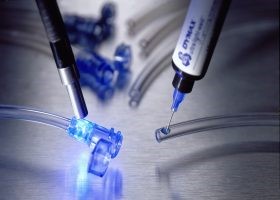Is Your Adhesive Fully Cured
Source : Dymax.com Edit : Ellsworth Adhesives

Ever been in the situation where you needed confirmation that your adhesive is fully cured before you moved on with your application? Do you know how to tell if it reached full cure?
The simple answer is that when the liquid adhesive turns into a solid –as a result of photo initiation, exposure to heat, or when mixed with an activator- it is cured.
The more detailed answer is applying this simple explanation to specific applications to prove the adhesive is completely cured. There are many variables which directly and indirectly influence the rate and extent of polymerization for a specific adhesive. These may include the following:
• The part substrate(s)
• UV/Visible light transmission through the substrate
• UV/Visible light intensity and exposure time
• Amount of adhesive or activator applied
• Oven temperature and time, etc.
A manufacturer using adhesives must first develop a process that will produce parts that meet all performance expectations. Assemblies must be built at the extremes of the process and be tested at the extremes of their integrity specifications. This is often referred to as PROCESS VALIDATION. For UV/Visible light-curable adhesives, this work may include destructive and performance testing of parts made with minimum and maximum amounts of adhesive, UV/Visible light intensity and exposure time allowable by the process.
Once the process is validated and documented, it is critical to maintain it. This ensures that all assemblies manufactured to the process, including the extent of cure of the UV adhesive, are exactly alike.
To monitor and maintain the process you may use radiometers, which measure UV and visible light transmission through clear and translucent plastics and the intensity of the cure lamps, and/or use meters for dispense equipment which regulate the amount of adhesive dispensed onto parts, etc.
The validation of the polymerization of the UV/Visible light curable adhesive must be done by the device manufacturer as each design and process is unique.
Some products in the market, like Dymax See-Cure products, allow the adhesive to appear in a distinctive color in an uncured state- blue in the case of See-Cure products. Upon reaching full cure under a light source of the proper wavelength, the blue color will disappear, leaving a colorless adhesive in the bond line. The product transitions colorless only it has reached enough energy to be fully cured. This adhesive color-changing technology was designed to incorporate a safety margin before the color change happens, so is a great way to not only build a process, but have a quality inspection system within the adhesive to tell you if you have reached full cure.










